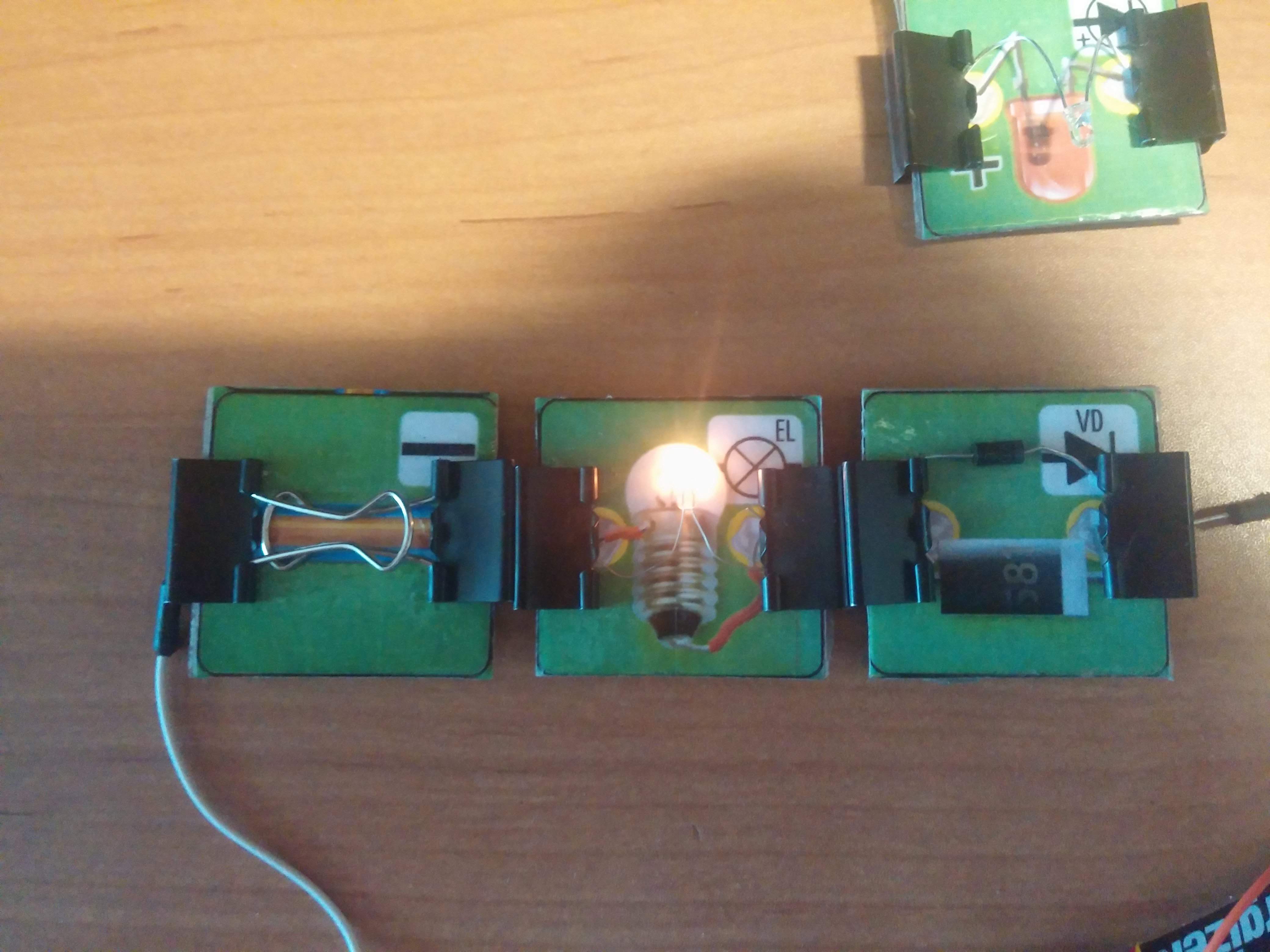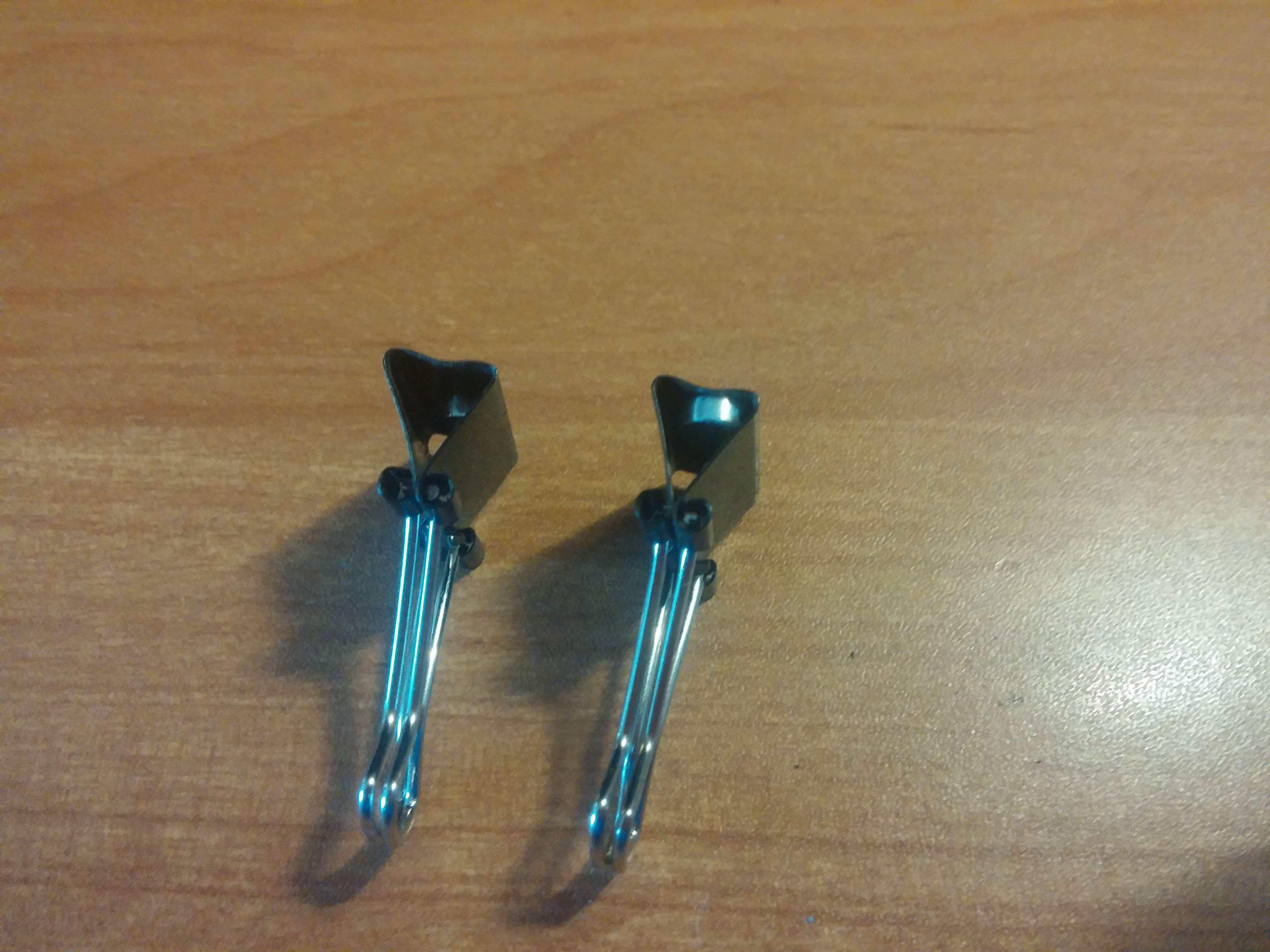Turn cardboard circuitry into a real one or how to make a simple constructor from a board game
Earlier, I already told how to make a homemade analogue of “electrical cubes” out of cardboard and how I came up with a board game for building electrical circuits (which after successfully raised funds for publishing through crowdfunding and which you can already buy).
After the launch of the publication of the game “Don't Short the Chain!”, The thought came to me: “What if the reverse process is done?”. That is, is it possible to turn square beautiful pieces of cardboard into components of a simple electrical designer and, preferably, without damaging the cardboard tokens of the game itself.
The call was accepted and the work began to boil.
')

It was also decided to take the magnetic attachment principle as a basis. The question was how to fix the magnets, what to make the contact pads of the components and, most importantly, how to manage with improvised means and make everything budget-friendly? Of course, it would be easy to make and print on the same 3D-printer of the case, place all the components, bend the contacts and cardboard cards out of metal into special recesses, but ... The solution was found more “elegant” and this ...
... Simple paper clips. Bought in the nearest stationery store. I used a width of 25 mm. I also needed magnets that can be ordered on a pile of sites with a diameter of 5 mm and a thickness of 2 mm. And some radio components and wires.
The first task (and the problem) to be solved is to make the clip conductive. It is covered with paint, which unfortunately does not conduct. There was mechanical work. We take sandpaper (or files) and “sand out” the paint from the ends of the clamp.


Then we “clamp” the skin and remove the paint from the inside (it is enough for us to get contact in the zone of contact between the “legs” of the clip).

Place a magnet in each clamp. The polarity does not matter, since the magnets are small and if you have not guessed with mutual polarity, they will just slightly move inside the clamp and pull the opposite one in any case.

After that, you can collect our first "electric" square. To do this, we take a card from the game (in the photo its prototype, but the real game is the same, only much prettier) and clamp it from two sides with the previously made “contacts” together with the desired radio component (light bulb, diode, resistor or LED).

After that, we “remove” the metal brackets and get the finished component.

To get blocks of conductors, you can “pinch” a piece of wire, but you can do it easier - it’s enough not to remove the spring clips of the clamps and just stick them together.

Moreover, this scheme as it turned out works as a switch - it is enough to lift one bracket, and the circuit is broken. In the same way the case is the T-shaped element. To intersect all four sides and intersecting conductors, it will be better to take and “clamp” pieces of wire (for intersections without insulation, and for intersections with insulation in the middle).
Similarly, you can make the switch.

Having spent a little time, we create the necessary number of components. It remains to connect the circuit to the power source. Terminals are also made from clips (or you can simply “magnetise” the conductors to the extreme contacts).

You can use the battery compartments, and you can simply connect the batteries through the same magnets.
We have a simple electrical circuit designer. What can it be used for? For example, to analyze the health of the schemes from the board game . I previously wrote that the game “engine” has certain limitations and we get a great way to check everything.

You can also show the influence of the polarity of the connection of semiconductors on their work, the effect of a resistor on the operation of components and other fundamentals of the construction of electrical circuits.

You can also show how parallel and serial connections work.

Someone may argue that it is too simple and not interesting, but for children the process of creating such a constructor and the transformation of a “soulless cardboard” into a working electrical circuit will be important. And then you can go to the mockups and more complex schemes, and return the board game to its original state and use it as a fascinating logical abstract, which is interesting to “kill yourself” from time to time for both children and adults.
After the launch of the publication of the game “Don't Short the Chain!”, The thought came to me: “What if the reverse process is done?”. That is, is it possible to turn square beautiful pieces of cardboard into components of a simple electrical designer and, preferably, without damaging the cardboard tokens of the game itself.
The call was accepted and the work began to boil.
')

It was also decided to take the magnetic attachment principle as a basis. The question was how to fix the magnets, what to make the contact pads of the components and, most importantly, how to manage with improvised means and make everything budget-friendly? Of course, it would be easy to make and print on the same 3D-printer of the case, place all the components, bend the contacts and cardboard cards out of metal into special recesses, but ... The solution was found more “elegant” and this ...
... Simple paper clips. Bought in the nearest stationery store. I used a width of 25 mm. I also needed magnets that can be ordered on a pile of sites with a diameter of 5 mm and a thickness of 2 mm. And some radio components and wires.
The first task (and the problem) to be solved is to make the clip conductive. It is covered with paint, which unfortunately does not conduct. There was mechanical work. We take sandpaper (or files) and “sand out” the paint from the ends of the clamp.


Then we “clamp” the skin and remove the paint from the inside (it is enough for us to get contact in the zone of contact between the “legs” of the clip).

Place a magnet in each clamp. The polarity does not matter, since the magnets are small and if you have not guessed with mutual polarity, they will just slightly move inside the clamp and pull the opposite one in any case.

After that, you can collect our first "electric" square. To do this, we take a card from the game (in the photo its prototype, but the real game is the same, only much prettier) and clamp it from two sides with the previously made “contacts” together with the desired radio component (light bulb, diode, resistor or LED).

After that, we “remove” the metal brackets and get the finished component.

To get blocks of conductors, you can “pinch” a piece of wire, but you can do it easier - it’s enough not to remove the spring clips of the clamps and just stick them together.

Moreover, this scheme as it turned out works as a switch - it is enough to lift one bracket, and the circuit is broken. In the same way the case is the T-shaped element. To intersect all four sides and intersecting conductors, it will be better to take and “clamp” pieces of wire (for intersections without insulation, and for intersections with insulation in the middle).
Similarly, you can make the switch.

Having spent a little time, we create the necessary number of components. It remains to connect the circuit to the power source. Terminals are also made from clips (or you can simply “magnetise” the conductors to the extreme contacts).

You can use the battery compartments, and you can simply connect the batteries through the same magnets.
We have a simple electrical circuit designer. What can it be used for? For example, to analyze the health of the schemes from the board game . I previously wrote that the game “engine” has certain limitations and we get a great way to check everything.

You can also show the influence of the polarity of the connection of semiconductors on their work, the effect of a resistor on the operation of components and other fundamentals of the construction of electrical circuits.

You can also show how parallel and serial connections work.

Someone may argue that it is too simple and not interesting, but for children the process of creating such a constructor and the transformation of a “soulless cardboard” into a working electrical circuit will be important. And then you can go to the mockups and more complex schemes, and return the board game to its original state and use it as a fascinating logical abstract, which is interesting to “kill yourself” from time to time for both children and adults.
Source: https://habr.com/ru/post/456056/
All Articles